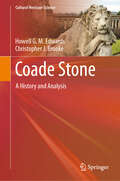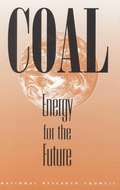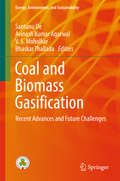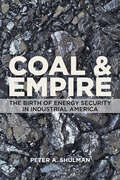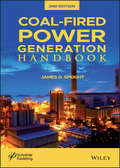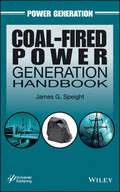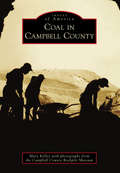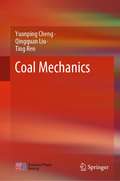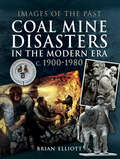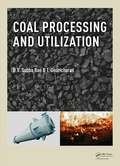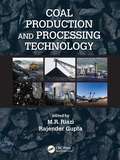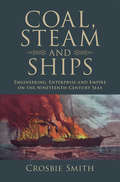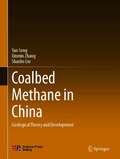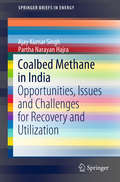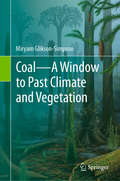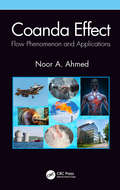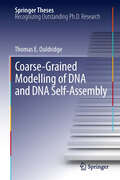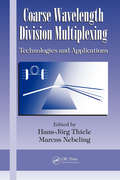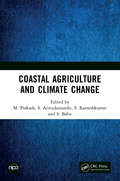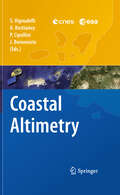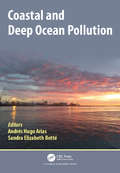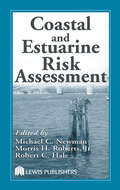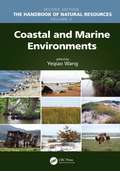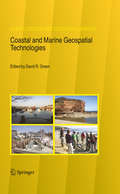- Table View
- List View
Coade Stone: A History and Analysis (Cultural Heritage Science)
by Howell G. Edwards Christopher J. BrookeThe history and nature of artificial stone for use in architecture is a subject still shrouded in myth and misconception. This book aims to lay bare those misconceptions and present a scientific and architectural account of these materials, and especially Coade Stone, the most successful of all, which found great favour during the Georgian period. Many examples of Coade Stone cast sculpture still exist and several key examples are presented in context and as case studies . Eleanor Coade’s artificial stone was so good that many observers could not distinguish it from the natural stone it replaced: the growth in replication of the neo-classical statuary and building adornment required in the late Georgian and Regency period was well satisfied by the use of Coade stone. A holistic evaluation of Coade stone artefacts is undertaken whereby the use of analytical data, historical documentation, invoices, company records, impressed marks and expert connoisseurship will establishthe attribution of Coade stone artefacts, some of which are currently in the unknown category. Several new scientific analyses are presented that demonstrate the true nature of high temperature fired ceramic Coade Stone and allow comparison with other forms of artificial stone, such as the cold cured cementitious variations, which eventually replaced it in the Victorian period.
Coal: Energy for the Future
by Committee on the Strategic Assessment of the U.S. Department of Energy's Coal ProgramThe U.S. Department of Energy (DOE) was given a mandate in the 1992 Energy Policy Act (EPACT) to pursue strategies in coal technology that promote a more competitive economy, a cleaner environment, and increased energy security.Coal evaluates DOE's performance and recommends priorities in updating its coal program and responding to EPACT.This volume provides a picture of likely future coal use and associated technology requirements through the year 2040. Based on near-, mid-, and long-term scenarios, the committee presents a framework for DOE to use in identifying R&D strategies and in making detailed assessments of specific programs.Coal offers an overview of coal-related programs and recent budget trends and explores principal issues in future U.S. and foreign coal use.The volume evaluates DOE Fossil Energy R&D programs in such key areas as electric power generation and conversion of coal to clean fuels.Coal will be important to energy policymakers, executives in the power industry and related trade associations, environmental organizations, and researchers.
Coal and Biomass Gasification: Recent Advances and Future Challenges (Energy, Environment, and Sustainability)
by Avinash Kumar Agarwal Santanu De V. S. Moholkar Bhaskar ThalladaThis book addresses the science and technology of the gasification process and the production of electricity, synthetic fuels and other useful chemicals. Pursuing a holistic approach, it covers the fundamentals of gasification and its various applications. In addition to discussing recent advances and outlining future directions, it covers advanced topics such as underground coal gasification and chemical looping combustion, and describes the state-of-the-art experimental techniques, modeling and numerical simulations, environmentally friendly approaches, and technological challenges involved. Written in an easy-to-understand format with a comprehensive glossary and bibliography, the book offers an ideal reference guide to coal and biomass gasification for beginners, engineers and researchers involved in designing or operating gasification plants.
Coal and Empire: The Birth of Energy Security in Industrial America
by Peter A. ShulmanThe fascinating history of how coal-based energy became entangled with American security.Since the early twentieth century, Americans have associated oil with national security. From World War I to American involvement in the Middle East, this connection has seemed a self-evident truth. But, as Peter A. Shulman argues, Americans had to learn to think about the geopolitics of energy in terms of security, and they did so beginning in the nineteenth century: the age of coal. Coal and Empire insightfully weaves together pivotal moments in the history of science and technology by linking coal and steam to the realms of foreign relations, navy logistics, and American politics. Long before oil, coal allowed Americans to rethink the place of the United States in the world.Shulman explores how the development of coal-fired oceangoing steam power in the 1840s created new questions, opportunities, and problems for U.S. foreign relations and naval strategy. The search for coal, for example, helped take Commodore Matthew Perry to Japan in the 1850s. It facilitated Abraham Lincoln's pursuit of black colonization in 1860s Panama. After the Civil War, it led Americans to debate whether a need for coaling stations required the construction of a global empire. Until 1898, however, Americans preferred to answer the questions posed by coal with new technologies rather than new territories. Afterward, the establishment of America's string of island outposts created an entirely different demand for coal to secure the country's new colonial borders, a process that paved the way for how Americans incorporated oil into their strategic thought. By exploring how the security dimensions of energy were not intrinsically linked to a particular source of power but rather to political choices about America's role in the world, Shulman ultimately suggests that contemporary global struggles over energy will never disappear, even if oil is someday displaced by alternative sources of power.
Coal-Fired Power Generation Handbook (Power Generation)
by James G. SpeightCoal accounts for approximately one quarter of world energy consumption and of the coal produced worldwide approximately 65% is shipped to electricity producers and 33% to industrial consumers, with most of the remainder going to consumers in the residential and commercial sectors. The total share of total world energy consumption by coal is expected to increase to almost 30% in 2035. This book describes the challenges and steps by which electricity is produced form coal and deals with the challenges for removing the environmental objections to the use of coal in future power plants. New technologies are described that could virtually eliminate the sulfur, nitrogen, and mercury pollutants that are released when coal is burned for electricity generation. In addition, technologies for the capture greenhouse gases emitted from coal-fired power plants are described and the means of preventing such emissions from contributing to global warming concerns. Written by one of the world’s leading energy experts, this volume is a must-have for any engineer, scientist, or student working in this field, providing a valuable reference and guide in a quickly changing field.
Coal-Fired Power Generation Handbook
by James SpeightThe most complete and up-to-date handbook on power generation from coal, this book covers all of today's new, cleaner methods for creating electricity from coal, the environmental challenges and concerns involved in its production, and developing technologies. It describes new technologies that could virtually eliminate the sulfur, nitrogen, and mercury pollutants released when coal is burned for electricity generation. In addition, the text details technologies for greenhouse gases capture from coal-fired power plants, as well as for preventing such emissions from contributing to global warming.
Coal in Campbell County (Images of America)
by Mary Kelley Campbell County Rockpile MuseumIn his Annual Report of the Territorial Geologist to the Governor of Wyoming 1890, Louis D. Ricketts wrote, "The coal of this district has little other use than that of supplying a local market." Years later, nothing could be further from the truth. The United States uses approximately one billion tons of coal a year, with about 390 million tons coming from Campbell County, Wyoming. Since large-scale commercial coal production began in Campbell County in the mid-1970s, most coal companies have changed names, owners, and boundaries several times. To let those changes go unrecorded would be to lose the very beginning of coal in Campbell County.
Coal Industry of the Former USSR: Coal Supply System and Industry Development
by A. B. Kovalchuk B. C. HardingeThe Coal Industry of the Former USSR presents a two-part study of coal supply systems and development of the industry in the territory of the former USSR. The first part covers the role of coal in the economy, provides an overview of current status and forecast of the eight major coal basins and environmental problems associated with the industry.
Coal Mechanics
by Yuanping Cheng Qingquan Liu Ting RenThis book focuses on the mechanical properties and permeability of coal, and the gas flow in coal seams. Based on coal permeability models, it establishes different models for coal seam gas, from the linear flow model to the gas–solid coupling flow model. It also provides the theoretical basis for the exploitation and safe production of coal as well as coal seam gas resources. As such, it is a valuable reference for researchers, advanced students and practitioners working in mining engineering and coalbed methane engineering.
Coal Mine Disasters in the Modern Era c. 1900–1980 (Images of the Past)
by Brian Elliott&“These haunting images, with well-researched facts, figures and timelines providing context, bring the bygone era of 20th-century coal mining to life.&”—Family Tree Although everyday fatalities in mines was far greater, it was the disasters that encouraged those in power to reform the way in which miners had to work underground, especially with regard to safety. And it would be no exaggeration to say that it was the disasters that greatly contributed to bringing the coal industry into national control. Sadly, for bereaved individuals and families, nothing could really compensate for the loss of one or more of a loved one. The impact of the big disasters, where hundreds of men and boys—one or two generations—were lost, immediately, the impact was massive, and continued to be felt many years afterwards. New and restored disaster memorials bear testimony to the great respect that former mining communities continue to have for their &“lost miners.&” Using many previously unpublished images, and a carefully supportive text, the author provides a detailed overview of mining disasters in the modern era, from the early 1900s to the 1980s. It is the first book of its kind to attempt such a large project in pictorial form with a foreword by Ceri Thompson, curator of the Big Pit, the Welsh national mining museum. The book is published at a particularly poignant time, after the recent closure of Britain&’s last deep coal mine. &“So many remarkable photographs and drawings: The story may be tragic, but it is one that lies at the very heart of the history of coal mining in Britain.&”—WDYTYA? magazine
Coal Processing and Utilization
by D.V. Subba Rao T. GouricharanThis book is a direct outgrowth of classes that the authors gave over a period of three decades to a university audience taking a Mineral Beneficiation course as a major that included coal processing and utilization. It is designed to be used as a student's (or layman's) first introduction to coal processing and utilization, motivating the concepts
Coal Production and Processing Technology (Fuels and Petrochemicals)
by M. R. Riazi Rajender GuptaCoal Production and Processing Technology provides uniquely comprehensive coverage of the latest coal technologies used in everything from mining to greenhouse gas mitigation. Featuring contributions from experts in industry and academia, this book:Discusses coal geology, characterization, beneficiation, combustion, coking, gasification, and liquef
Coal, Steam and Ships: Engineering, Enterprise and Empire on the Nineteenth-Century Seas (Science in History)
by Crosbie SmithCrosbie Smith explores the trials and tribulations of first-generation Victorian mail steamship lines, their passengers, proprietors and the public. Eyewitness accounts show in rich detail how these enterprises engineered their ships, constructed empire-wide systems of steam navigation and won or lost public confidence in the process. Controlling recalcitrant elements within and around steamship systems, however, presented constant challenges to company managers as they attempted to build trust and confidence. Managers thus wrestled to control shipbuilding and marine engine-making, coal consumption, quality and supply, shipboard discipline, religious readings, relations with the Admiralty and government, anxious proprietors, and the media - especially following a disaster or accident. Emphasizing interconnections between maritime history, the history of engineering and Victorian culture, Smith's innovative history of early ocean steamships reveals the fraught uncertainties of Victorian life on the seas.
Coalbed Methane in China: Geological Theory and Development
by Yan Song Xinmin Zhang Shaobo LiuThe coalbed methane (CBM) reserve in China ranks third in the world with a total resource of 36.8×1012 m3. Exploitation of CBM has an important practical significance to ensure the long-term rapid development of China natural gas industry. Therefore, in 2002, the Ministry of Science and Technology of China set up a national 973 program to study CBM system and resolve problems of CBM exploration and exploitation in China. All the main research results and new insights from the program are presented in this book. The book is divided into 11 chapters. The first chapter mainly introduces the present situation of CBM exploration and development in China and abroad. Chapters 2 through 9 illustrate the geological theory and prospect evaluation methods. Then chapters 10 and 11 discuss CBM recovery mechanisms and technology. The book systematically describes the origin, storage, accumulation and emission of CBM in China, and also proposes new methods and technologies on resource evaluation, prospect prediction, seismic interpretation and enhanced recovery. The book will appeal to geologists, lecturers and students who are involved in the CBM industry and connected with coal and conventional hydrocarbon resources research.
Coalbed Methane in India: Opportunities, Issues and Challenges for Recovery and Utilization (SpringerBriefs in Energy)
by Ajay Kumar Singh Partha Narayan HajraThis book offers a first-of-its-kind, standalone review of coalbed methane (CBM) in India, covering all the major technical and policy aspects. As an authoritative text on CBM in India, it addresses the essential geological, engineering and policy issues. The Coalbed Methane industry is a rapidly developing sector in Indian energy supply. The book presents the characteristics of coal beds in India's Damodar and Son river valleys, which influence the commercial viability of CBM in the regions, as well as a study of the gas contents of the country's major coalfields. The book begins with a brief review of methane emissions from Indian coal mines and the current coalbed methane situation in the country. Its unique features include a coalfield-by-coalfield technical assessment of CBM throughout India. Policy matters are addressed, including the National Exploration Licencing Policy (NELP) of the Indian Government Ministry of Petroleum and Natural Gas, which is vital to an overall understanding of CBM development in the country. The scope and depth of its book's coverage will benefit students, practising engineers, researchers and policy-makers.
Coal—A Window to Past Climate and Vegetation
by Miryam Glikson-SimpsonThis book focuses on the Permian time slice in the geological history of Gondwana, which includes Australia, India, South Africa, Antarctica and South America. Coal is an organic rock, the product of compressed and ‘cooked’ plants. The exact formation of coal via physicochemical reactions, burial and subsidence is the subject of numerous books. The vast thick coal deposits characterising Gondwana formed from special kind of trees termed the Glossopteris Flora. These trees shed their leaves in winter and with the rest of their remains decayed and through subsidence and burial formed the coal. Pollen preserved from these plant communities has been concentrated and isolated and is the focus of this book. The first plant communities as can be seen from the pollen graphs in this book were impoverished in species. The Permian era started with a very cold climate and as the climate warmed more and more diverse vegetation took hold. The emergence of different forms of pollen at certain times in the Permian is used as an indicator of climatic change. Furthermore, the predominance of algal spores in some samples and lack of representation by pollen of Glossopteris point to significant changes in the climate which led to the disappearance of their pollen and the accumulation of spores representing algal communities. These climate induced changes are noticed in their completed transformation after a long time span; small changes are evident during a lifetime of Earth’s inhabitants. Today, in our lifetime, we can see and witness the drying of many lakes across the Earth and their total disappearance from maps of only 50 years ago is a testimony to a climatic change taking place. The time of a ‘complete’ change in the Permian is possible to calculate. However, to determine the duration and maximum change in the climate of the earth today is impossible due to the apparent acceleration of the process by industrial activities of our species. Chapter 4 in the book deals with the special characteristics of the Permian coals of Gondwana and the special plant community which made them. The composition of these coals on a microscopic level shows them to be rich in hydrocarbons, more than other coals. The Permian coals of India and Australia generate ‘heavy’ oil which is retained within the coal matrix as bitumen and is a potential source of methane. This chapter demonstrates through a pilot study the potential for explosion in the Permian Gondwana coals through their propensity to spontaneous combustion and methane generation.
Coanda Effect: Flow Phenomenon and Applications
by Noor A AhmedCoanda effect is a complex fluid flow phenomenon enabling the production of vertical take-off/landing aircraft. Other applications range from helicopters to road vehicles, from flow mixing to combustion, from noise reduction to pollution control, from power generation to robot operation, and so forth. Book starts with description of the effect, its history and general formulation of governing equations/simplifications used in different applications. Further, it gives an account of this effect’s lift boosting potential on a wing and in non-flying vehicles including industrial applications. Finally, occurrence of the same in human body and associated adverse medical conditions are explained.
Coarse-Grained Modelling of DNA and DNA Self-Assembly (Springer Theses)
by Thomas E. OuldridgeThis thesis presents a novel coarse-grained model of DNA, in which bases are represented as rigid nucleotides. The model is shown to quantitatively reproduce many phenomena, including elastic properties of the double-stranded state, hairpin formation in single strands and hybridization of pairs of strands to form duplexes, the first time such a wide range of properties has been captured by a coarse-grained model. The scope and potential of the model is demonstrated by simulating DNA tweezers, an iconic nanodevice, and a two-footed DNA walker -- the first time that coarse-grained modelling has been applied to dynamic DNA nanotechnology.
Coarse Wavelength Division Multiplexing: Technologies and Applications (Optical Science and Engineering)
by Hans-Jörg Thiele Marcus NebelingExplaining what CWDM is, how it is achieved, and why it should be deployed, Coarse Wavelength Division Multiplexing: Technologies and Applications merges coverage of isolated aspects of Coarse Wavelength Division Multiplexing (CWDM) traditionally found as device-related or specific system topics. Emphasizing cost savings and performance enhancement, the book integrates information on component issues, system architectures, concepts for extensions and upgrades, as well as practical applications into a comprehensive, single-volume resource. Beginning with a summary of the ITU-T standards defining CWDM, the book addresses the three essential component classes, optical fibers, transceivers, and WDM filters, which combine to form the basis for the CWDM transmission link. The following chapters include coverage of different architectures such as hubbed rings and meshed networks, and upgrade paths to overcome limitations of current CWDM systems. The book outlines the feasibility of optically amplified CWDM systems, investigates the challenges present with high-speed CWDM and bidirectional transmission, and finally elucidates the importance of CWDM for a wide range of applications. Each chapter provides sufficient information to be used independently and contains references to relevant papers and articles for further study. The last sections of the book focus on applications and case studies where CWDM plays an ever-increasing role. They include extensive studies on networking, reach extension by amplification, and the latest concepts of transmission capacity upgrades using increased bit-rates or new channel plans. Filled with practical information, the book provides a clear understanding of recent developments in the dynamic field of CWDM.
Coastal Agriculture and Climate Change
by M. PrakashChanging climate in micro and macro level attribute to influence and bring changes in productivity and production trend of every industry including agriculture and its ecosystem. The influence of climate change and its environmental impact on coastal ecosystem greatly influence the life and livelihood of agrarian communities and people involved in allied industries. The book has been authored with objectives of providing understanding on the environmental problems, features of coastal ecosystem, advanced strategies for environmental protection, mitigation strategies for environmental problems in coastal areas and augmenting agriculture income from coastal areas.Note: T&F does not sell or distribute the hardback in India, Pakistan, Nepal, Bhutan, Bangladesh and Sri Lanka. This title is co-published with NIPA.
Coastal Altimetry
by Andrey G. Kostianoy Jérôme Benveniste Paolo Cipollini Stefano VignudelliThe book describes experience in application of coastal altimetry to different parts of the World Ocean. It presents the principal problems related to the altimetry derived products in coastal regions of the ocean and ways of their improvement. This publication is based on numerous satellite and observational data collected and analyzed by the authors of the various chapters in the framework of a set of international projects, performed in UK, France, Italy, Denmark, Russia, USA, Mexico and India. The book will contribute both to the ongoing International Altimeter Service effort and to the building of a sustained coastal observing system in the perspective of GMES (Global Monitoring for Environment and Security) and GEOSS (Global Earth Observation System of Systems) initiatives. This book is aimed at specialists concerned with research in the various fields of satellite altimetry, remote sensing, and coastal physical oceanography. The book will be also interesting for lecturers, students and post-graduate students.
Coastal and Deep Ocean Pollution
by Andrés Hugo Arias; Sandra Elizabeth BottéDuring the recent decades, social, political and academic endeavours have been made to improve environmental quality and reduce pollution. In particular, the ocean, sea and coastal areas show varying degrees of impact from the multiple human activities carried out in the terrestrial as well as in the aquatic environment. Ecology is a science which studies the relationship between organisms and the surrounding environment and in the modern era, the marine world is getting increasing attention. For centuries it has been the final reservoir of human garbage; later it became an oil farm with a concomitant increase of coastal population growth and unplanned growth of the fishing industry and the increasing use of sea routes for cargo transport and recreational uses (cruises). All this led to rising contamination with negative effects on biota and even human health. It is then imperative to know the current situation of the world's oceans: that is the main purpose of this book, to document at a glance the latest research in the field of ocean pollution.
Coastal and Estuarine Risk Assessment (Environmental and Ecological Risk Assessment)
by Michael C. Newman Morris H. Roberts Robert C. HaleWritten by experts in the field, Coastal and Estuarine Risk Assessment explores the science of exposure, effect, and risk. This is the first book to address the application of the current risk assessment paradigm from the National Research Council to coastal and estuarine environments. It provides the necessary applications for modifying the paradigm and shows how to use it to perform an effective assessment. Topics include: fate and bioavailability of organic compounds, emerging contaminants, effects of populations, effects to marine mammals, risk from multiple stressors, European approaches to risk assessment, effects of land use, and more.
Coastal and Marine Environments
by Yeqiao WangAuthored by world-class scientists and scholars, The Handbook of Natural Resources, Second Edition, is an excellent reference for understanding the consequences of changing natural resources to the degradation of ecological integrity and the sustainability of life. Based on the content of the bestselling and CHOICE-awarded Encyclopedia of Natural Resources, this new edition demonstrates the major challenges that the society is facing for the sustainability of all well-being on the planet Earth. The experience, evidence, methods, and models used in studying natural resources are presented in six stand-alone volumes, arranged along the main systems of land, water, and air. It reviews state-of-the-art knowledge, highlights advances made in different areas, and provides guidance for the appropriate use of remote sensing and geospatial data with field-based measurements in the study of natural resources. Volume 5, Coastal and Marine Environments, discusses marine and coastal ecosystems, their biodiversity, conservation, and integrated marine management plans. It provides fundamental information on coastal and estuarine systems and includes discussions on coastal erosion and shoreline change, natural disasters, evaporation and energy balance, fisheries and marine resource management, and more. New in this edition are discussions on sea level rise, renewable energy, coral reef restoration, fishery resource economics, and coastal remote sensing. This volume demonstrates the key processes, methods, and models used through many case studies from around the world. Written in an easy-to-reference manner, The Handbook of Natural Resources, Second Edition, as individual volumes or as a complete set, is an essential reading for anyone looking for a deeper understanding of the science and management of natural resources. Public and private libraries, educational and research institutions, scientists, scholars, and resource managers will benefit enormously from this set. Individual volumes and chapters can also be used in a wide variety of both graduate and undergraduate courses in environmental science and natural science at different levels and disciplines, such as biology, geography, earth system science, and ecology.
Coastal and Marine Geospatial Technologies (Coastal Systems and Continental Margins #13)
by D. R. GreenThis international collection of papers represents a selected and up-to-date overview of some of the main areas of research into the application of the geospatial technologies, including geographical information systems (GIS), remote sensing, digital mapping, global positioning systems (GPS), databases, Internet technology, and mobile field-data collection and mapping, to coastal and marine environments around the World. Aimed at the researcher, editor, practitioner and student, this volume seeks to expand the available literature in a rapidly expanding and evolving area, namely the coastal and marine environment. The book comes at a time when there is growing concern about global warming, climate change, and sea level rise, all of which will have an impact upon coastal areas. These geospatial technologies offer the possibility to gather unique environmental data to study the coast, to process the data into information, to visualise data and landscapes, to gather data in the field, and to involve stakeholders in coastal management amongst other things. Considerable potential now exists to raise awareness, to educate and to embrace these technologies as one way to promote greater knowledge and understanding of our marine and coastal environments.
